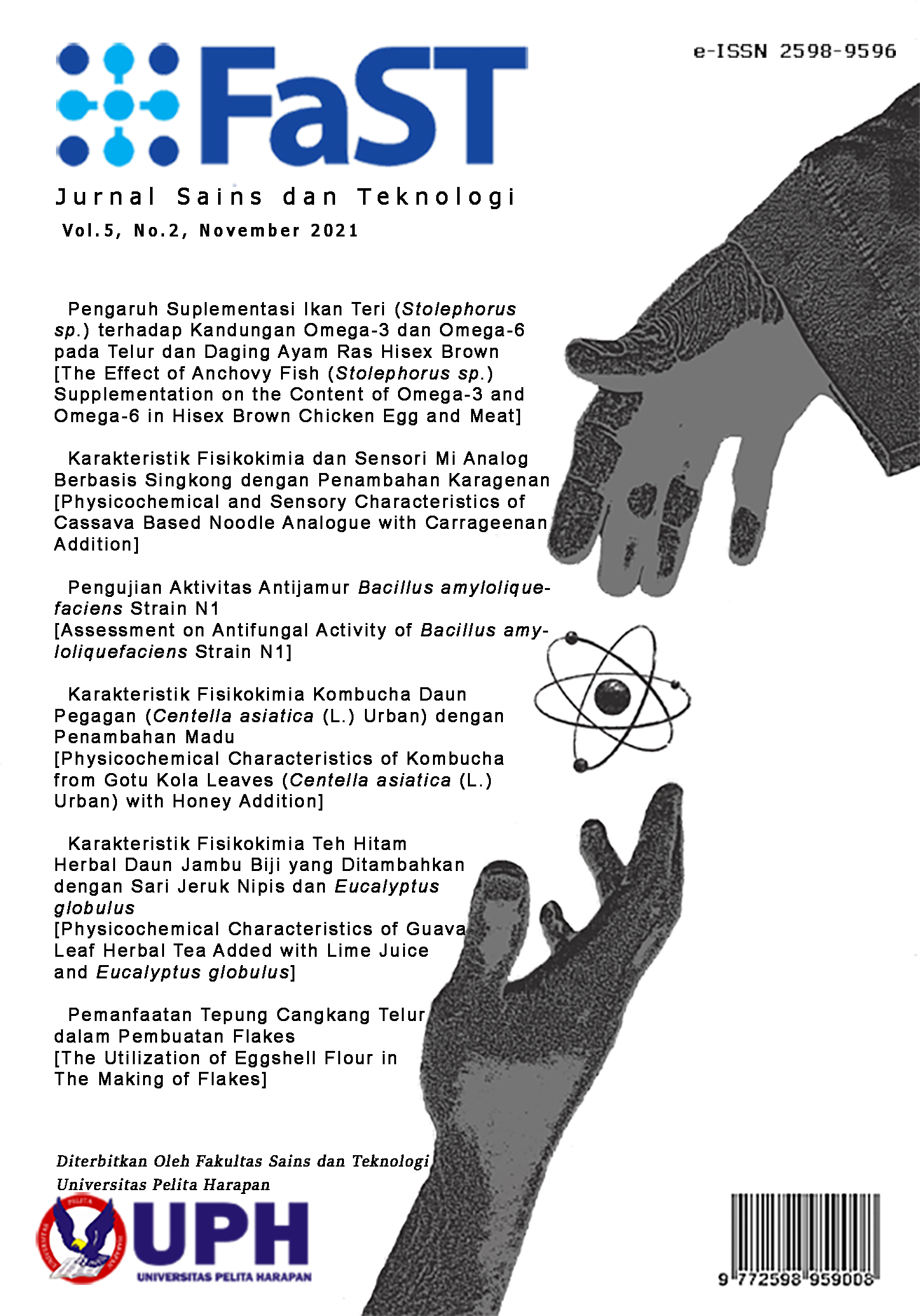PENGUJIAN AKTIVITAS ANTIJAMUR Bacillus amyloliquefaciens STRAIN N1 [ASSESSMENT ON ANTIFUNGAL ACTIVITY OF Bacillus amyloliquefaciens STRAIN N1]
Kata Kunci:
Antifungal, Aspergillus welwitschiae, Bacillus amyloliquefaciens strain N1, Bioinformatic analyses, Penicillium sp.Abstrak
The negative impact of fungal contamination in food products is profound. The contamination could be caused by fungi that threatens human health as well. Effective and safe antifungal compounds therefore are crucial to control this issue. It had been reported that certain strains of Bacillus amyloliquefaciens exerted an antifungal activity. As a strain of Bacillus amyloliquefaciens (called strain N1) had been isolated by our laboratory from a chicken gizzard, we investigated whether this strain had an antifungal activity as well. Two species of fungi, i.e., Aspergillus welwitschiae and Penicillium sp., were utilized as the target in the whole-cell co-culture method. The result showed that Bacillus amyloliquefaciens strain N1 significantly inhibited the growth of Aspergillus welwitschiae and Penicillium sp. (percentages of inhibition were 73.3% and 100%, respectively). Next, with the availability of whole genome data of Bacillus amyloliquefaciens strain N1, the bioinformatic analyses with RAST and nucleotide BLAST database suggested that Bacillus amyloliquefaciens strain N1 could secrete antifungal compounds of bacillomycin D, surfactin and fengycin. In conclusion, Bacillus amyloliquefaciens strain N1 has a potential to be further utilized due to the presence of its antifungal activity.
BAHASA INDONESIA ABSTRAK:
Dewasa ini, permasalahan kontaminasi pada produk makanan banyak ditemukan. Kontaminasi ini dapat disebabkan, salah satunya oleh jamur yang dapat mengancam kesehatan manusia. Oleh karena itu, senyawa antijamur yang efektif dan aman dibutuhkan untuk mengendalikan permasalahan ini. Berdasarkan penelitian terdahulu, strain tertentu dari bakteri Bacillus amyloliquefaciens diketahui memiliki aktivitas antijamur. Pada penelitian ini, isolat bakteri Bacillus amyloliquefaciens strain N1 yang berhasil diisolasi dari tembolok ayam oleh laboratorium Program Studi Biologi Universitas Pelita Harapan diteliti kemampuan aktivitas antijamurnya. Dua spesies jamur, Aspergillus welwitschiae dan Penicillium sp. dipergunakan sebagai target dalam percobaan dengan metode whole-cell co-culture. Hasil percobaan menunjukkan bahwa Bacillus amyloliquefaciens strain N1 menghambat pertumbuhan Aspergillus welwitschiae dan Penicillium sp. masing-masing sebesar 73,3% dan 100%. Percobaan selanjutnya adalah analisis bioinformatika dengan RAST dan nucleotide BLAST database berhubung tersedianya data whole genome dari Bacillus amyloliquefaciens strain N1, dimana ditunjukkan kemungkinan bahwa senyawa antijamur yang dihasilkan adalah bacillomycin D, surfactin dan fengcyn. Kesimpulan kami adalah bahwa Bacillus amyloliquefaciens strain N1 memiliki potensi untuk dipergunakan lebih lanjut berkat aktivitas antijamurnya.
Kata kunci: analisis bioinformatika; antijamur; Aspergillus welwitschiae; Bacillus amyloliquefaciens strain N1; Penicillium sp.Referensi
Damayanti, E., Suryani, A.E., Sofyan, A., Karimy, M.F., & Julendra, H. (2015). Seleksi Bakteri Asam Laktat dengan Aktivitas Anti Jamur yang Diisolasi dari Silase dan Saluran Cerna Ternak (Isolation of Lactic Acid Bacteria for Antifungal Activity Isolated from Silage and Animal Digestives Tract). Jurnal Agritech, 35(02), 164. https://doi.org/10.22146/agritech.9402
Kim, M.J., Radhakrishnan, R., Kang, S.M., You, Y.H., Jeong, E.J., Kim, J.G., & Lee, I.J. (2017). Plant Growth Promoting Effect of Bacillus amyloliquefaciens H-2-5 on Crop Plants and Influence on Physiological Changes in Soybean under Soil Salinity. Physiology and Molecular Biology of Plants, 23(3), 571-80. https://doi.org/10.1007/s12298-017-0449-4
Koumoutsi, A., Chen, X.H., Vater, J., & Borriss, R. (2007). DegU and YczE Positively Regulate the Synthesis of Bacillomycin D by Bacillus amyloliquefaciens Strain FZB42. Applied and Environmental Microbiology, 73 (21), 6953-64. https://doi.org/10.1128/AEM.00565-07
Lee, T., Park, D., Kim, K. Lim, S.M., Yu, N.H., Kim, S., Kim, H.Y., Jung, K.S., Jang, J.Y., Park, J.C., Ham, H., Lee, S., Hong, S.K., & Kim, J.C. (2017). Characterization of Bacillus amyloliquefaciens DA12 Showing Potent Antifungal Activity against Mycotoxigenic Fusarium Species. Plant Pathology Journal, 33(5), 499-507. https://doi.org/10.5423/PPJ.FT.06.2017.0126
Li, X., Zhang, Y., Wei, Z., Guan, Z., Cai, Y., & Liao, X. 2016. Antifungal Activity of Isolated Bacillus amyloliquefaciens SYBC H47 for the Biocontrol of Peach Gummosis. PLoS ONE, 11(9), 1-22. https://doi.org/10.1371/journal.pone.0162125
Mardanova, A.M., Hadieva, G.F., Lutfullin, M.T., Khilyas, I.V., Minnullina, L.F., Gilyazeva, A.G., Bogomolnaya, L.M., & Sharipova, M.R. (2017). Bacillus subtilis Strains with Antifungal Activity against the Phytopathogenic Fungi. Agricultural Sciences, 08(01), 1-20. http://dx.doi.org/10.4236/as.2017.81001
Meena, K.R., & Kanwar, S.S. 2015. Lipopeptides as the Antifungal and Antibacterial Agents. BioMed Research International, 2015, 1-9. https://doi.org/10.1155/2015/473050
Nett, J.E., & Andes, D.R. (2016). Antifungal Agents: Spectrum of Activity, Pharmacology, and Clinical Indications. Infectious Disease Clinics of North America, 30(1), 51-83. https://doi.org/10.1016/j.idc.2015.10.012
Rabbee, M.F., & Baek, K.H. (2020). Antimicrobial Activities of Lipopeptides and Polyketides of Bacillus velezensis for Agricultural Applications. Molecules, 25(21). https://doi.org/10.3390/molecules25214973
Radi, N.A.M., Abdelmonem, A.A., & Ziada, A.A. (2017). A Study on the Antifungal Effects of Lactobacillus Spp. on Candida Species. The Egyptian Journal of Medical Microbiology, 26(3), 25-29.
Sarwar, A., Hassan, M.N., Imran, M., Iqbal, M., Majeed, S., Brader, G., Sessitsch, A., & Hafeez, F.Y. (2018). Biocontrol Activity of Surfactin A Purified from Bacillus NH-100 and NH-217 against Rice Bakanae Disease. Microbiological Research, 209, 1-13. https://doi.org/10.1016/j.micres.2018.01.006
Tao, Y., Bie, X., Lv, F., Zhao, H., & Lu, Z. (2011). Antifungal Activity and Mechanism of Fengycin in the Presence and Absence of Commercial Surfactin Against Rhizopus stolonifer. Journal of Microbiology, 49(1), 146-50. https://doi.org/10.1007/s12275-011-0171-9
Vitullo, D., Di Pietro, A., Romano, A., Lanzotti, V., & Lima, G. (2012). Role of New Bacterial Surfactins in the Antifungal Interaction between Bacillus amyloliquefaciens and Fusarium oxysporum. Plant Pathology, 61(4), 689-99. https://doi.org/10.1111/j.1365-3059.2011.02561.x

Unduhan
Diterbitkan
Terbitan
Bagian
Lisensi
“Authors who publish with this journal agree to the following terms:
1) Authors retain copyright and grant the journal right of first publication with the work simultaneously licensed under a Creative Commons Attribution License (CC-BY-SA 4.0) that allows others to share the work with an acknowledgement of the work's authorship and initial publication in this journal.
2) Authors are able to enter into separate, additional contractual arrangements for the non-exclusive distribution of the journal's published version of the work (e.g., post it to an institutional repository or publish it in a book), with an acknowledgement of its initial publication in this journal.
3) Authors are permitted and encouraged to post their work online (e.g., in institutional repositories or on their website). The final published PDF should be used and bibliographic details that credit the publication in this journal should be included.”




